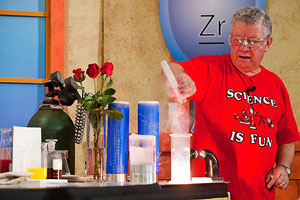Book series explores chemistry’s panache
When chemistry’s preeminent impresario Bassam Shakhashiri mounts the dais, you know the show is about to begin.

Bassam Shakhashiri performs before an audience filled with children and their parents during his annual “Once Upon a Christmas Cheery In the Lab of Shakhashiri” demonstration program in the Chemistry Building on Dec. 5, 2009.
Photo: Jeff Miller
It might be vanishing beakers or colorful battery-fueled chemical reactions. It could be spinning light sticks or, on occasion, something that goes boom. But whatever the professor has up his lab coat sleeve, you can be sure that there is a valuable take-home lesson about science and why we should care about it.
“The idea is not to just put on a whiz bang show,” Shakhashiri explains. “Anybody can blow things up. The idea is to share core values.”
For the Lebanese-born chemist and the president-elect of the American Chemical Society, nifty and sometimes spectacular demonstrations are the means to an end. The end being a broader and deeper public understanding and appreciation of science. “Science needs fans,” says Shakhashiri. “We’re developing an attitude. That’s what science literacy is. It’s an attitude.”
For 40 years, Shakhashiri has been working to cultivate that attitude. He’s done it by invitation at the White House and in the power corridors of Washington. He does it, in the tradition of the great British scientist Michael Faraday, to packed auditoria for his annual public lectures at Christmastime. He travels the world spreading the gospel that science and chemistry, in particular, are not only fun and interesting, but that they are important elements of our daily lives that we should know about.
And since 1983, Shakhashiri and his collaborators have worked to create a cadre of sophisticated science acolytes by publishing a series of hefty, beautiful, heavily illustrated Chemical Demonstrations handbooks. Written for teachers, the books are a way to breathe life into science lessons that all too often lack dimension, context and the natural excitement of discovery.
“The series is aimed at teachers at the college and high school levels. The idea is to empower them to effectively communicate science in the classroom, and also to other public audiences,” notes Shakhashiri.
In addition to the formal classroom, the handbook is also widely used by people in museums, industry, chemistry clubs and other informal settings.
The most recent in the UW Press Chemical Demonstrations series, Volume 5, seeks to illustrate the chemistry of color, light, vision and perception. Light and color pervade the practice of modern chemistry, and such things as vision and the functioning of the human brain are underpinned by elegant and pervasive chemical reactions in the body.
“Vision is a chemical reaction,” says Shakhashiri. “The eyes are part of the brain” and the brain is a cauldron of chemical reactions as it processes visual and other cues. Chemiluminescence, the release of light energy through chemical reactions, and the technology that underpins light-emitting diodes are further examples of chemistry at the interface of light, and each has a section in the handbook, complete with step-by-step directions for demonstrations to bring the science to life.
“One purpose of a demonstration is to get your attention, to get you engaged,” explains Shakhashiri. “And once you decide to be engaged, you’re on a journey.”
The series begun almost 30 years ago by Shakhashiri and his colleagues has been one of the most popular in the UW Press stable, according to Chris Caldwell of UW Press. “It has had a long and prosperous life,” says Caldwell of the series. “They’re classics that are used year in and year out.”
The series is in use around the world, notes Shakhashiri, and has been translated into several other languages. To see the demonstrations Shakhashiri and his collaborators have so painstakingly devised in broad use over the years is heartening, says the UW–Madison chemist.
“These are fun things. And when I talk about fun I’m talking about fun in the best sense of the word. I want to share the joy of science. Demonstrations are the vehicle.”




